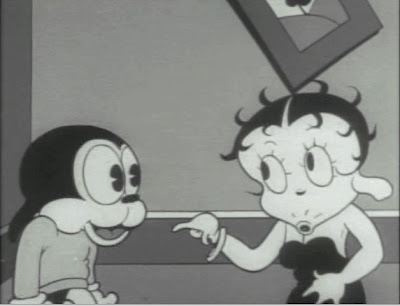 It exemplifies the fun, excitement and creative spirit of the most creative age of animation.
It exemplifies the fun, excitement and creative spirit of the most creative age of animation. After being somewhat stagnant for almost 20 years, animation experienced a creative explosion after the arrival of sound.
After being somewhat stagnant for almost 20 years, animation experienced a creative explosion after the arrival of sound. I don't know if sound spurred it, or if it just happened by chance at the same time, but for about 10 years animation explored ideas and techniques with a wild abandon.
I don't know if sound spurred it, or if it just happened by chance at the same time, but for about 10 years animation explored ideas and techniques with a wild abandon. There was an anything goes spirit in the air - which is actually animation's most natural urge, an urge that to be suppressed has to be crushed under huge and unnatural pressures. It used to be axiomatic that "You can do anything in cartoons".
There was an anything goes spirit in the air - which is actually animation's most natural urge, an urge that to be suppressed has to be crushed under huge and unnatural pressures. It used to be axiomatic that "You can do anything in cartoons". The creative growth of the 30s continued at a slower pace in the 40s - mostly at Warner Bros.
The creative growth of the 30s continued at a slower pace in the 40s - mostly at Warner Bros. At Disney's the creative emphasis changed from its earlier period of exploration to a new era of preservation (and endless repetition) of previously discovered techniques and the codifying of rules.
At Disney's the creative emphasis changed from its earlier period of exploration to a new era of preservation (and endless repetition) of previously discovered techniques and the codifying of rules. It was the difference between the Hellenic and the Hellenistic periods of philosophy. Egyptian librarians followed by medieval monks blindly preserved abstract rules that were unintended by the earlier creators who simply explored and unearthed the new and exciting. Curiosity was replaced by dogma. This scholastic tendency led to inevitable decay as each succeeding generation lost more of what it was trying to preserve.
It was the difference between the Hellenic and the Hellenistic periods of philosophy. Egyptian librarians followed by medieval monks blindly preserved abstract rules that were unintended by the earlier creators who simply explored and unearthed the new and exciting. Curiosity was replaced by dogma. This scholastic tendency led to inevitable decay as each succeeding generation lost more of what it was trying to preserve. By the 1950s, entertainment cartoons became fairly stale and formulaic in general, while the last vestiges of exploration, fun and cartooniness flourished in - of all places - animated commercials on TV.
By the 1950s, entertainment cartoons became fairly stale and formulaic in general, while the last vestiges of exploration, fun and cartooniness flourished in - of all places - animated commercials on TV.











There was a slight return of creative spirit in the early 90s, but that quickly degenerated by the end of the decade into hidebound stifling formula (the age of 'tude), both in feature animation and flash animation. Those trends were accompanied by another - an unfathomable glorification of the primitive on television.
I wonder when we'll see a return to the days of trying anything that will wow an audience, a release from the great fear we have of the spontaneous creativity and natural entertainment of talent.





































